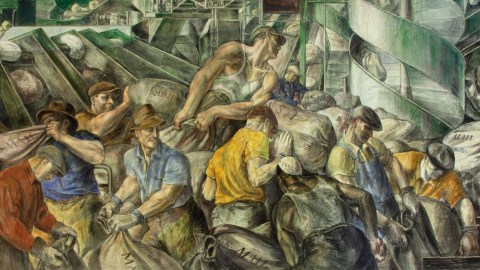We need “good jobs” to restore trust and save capitalism

- Workers are quitting their jobs at a record rate, and America has lost its healthy middle class.
- Young people are skeptical of capitalism and are becoming convinced that the only way to create a strong middle class is to unionize.
- CEOs and other corporate leaders need to reestablish trust in the marketplace, not just with low-wage workers but with customers. Focusing on creating good jobs can help.
The world is profoundly different today than it was nearly a decade ago when I first set out to convince companies of the value of good jobs. While good jobs alone won’t solve all the following problems, it is hard to see how they can be solved without good jobs.
Workers are quitting their jobs at a record rate, especially in the low-wage sectors of the economy. Quit rates were already increasing since 2009 and the Covid-19 pandemic accelerated the trend, with record quit rates observed in 2021. From healthcare facilities to call centers, from fulfillment centers to factories, companies are having such trouble finding workers that some are adding signing bonuses as high as $3,000.
America has lost its healthy middle class. Even before the pandemic, 53 million people—44 percent of the workforce—worked in jobs for which the median annual pay was just $17,950. Black and Hispanic Americans are disproportionately represented in these low-wage jobs; economic and racial justice are, as Martin Luther King Jr. reminded us, inexorably linked. “Upskilling” workers to better jobs sounds good on paper but won’t solve the problem, in part because most job growth is expected to come in low-wage sectors. Caregiving jobs are the fastest-growing occupation and are also notoriously bad jobs. But in fact, it isn’t necessary that caregivers, waitresses, and so on upskill to become nurses and computer programmers. The jobs they have right now—in retail, restaurants, call centers, and senior living facilities—are important and can be good jobs with living wages, decent benefits, and opportunities for growth and success.
Indeed, many Americans are losing faith in market economies altogether, believing that capitalism inherently creates inequality and injustice. Even before the pandemic, 70 percent of Americans believed the economic system was rigged against them; 47 percent believed that capitalism does more harm than good. Life expectancy in the United States has been declining since 2014. A major reason for the decline, according to economists Anne Case and Angus Deaton, is “deaths of despair”; that is, deaths from drug overdose, alcohol-related liver disease, and suicide. Even among those who have succeeded most in this system, there are corporate leaders who believe that capitalism is broken.
Young and ambitious people are increasingly convinced that the only way to create a strong middle class and improve things for workers is to unionize for power. The pandemic amplified the pent-up pressures—unlivable pay, unstable schedules, and lack of voice, respect, and dignity. As I write these pages in October 2022, unionization—from Starbucks to Apple to Amazon—is on the rise.
On April 1, 2022, Chris Smalls made the news when he and his peers won one of the most historic labor victories in this generation: 2,654 workers at Amazon’s Staten Island fulfillment center voted for the union and 2,131 voted against. Shortly after the victory, Smalls appeared on The Daily Show with Trevor Noah. Noah pointed out how dystopian the Amazon work environment seemed to those of us on the outside hearing about workers urinating in plastic bottles and about how, on Easter, Amazon posted a sign thanking workers for working on the holiday and told them that if they meet their quota, they may win a goody bag—water or soda plus a candy bar or a bag of chips—worth roughly two dollars. He asked Smalls if it was really that bad. The part of Smalls’s response that really hit me was that “there was no human aspect” to the job. You don’t have interactions with your managers, you don’t move up, and if you get fired, it will be done by an app. Smalls brought up Amazon founder Jeff Bezos’s trip to space in July 2021, in the middle of the pandemic, when Amazon workers were risking their health to work. After the eleven-minute thrill, Bezos said, “I want to thank every Amazon employee and every Amazon customer because you guys paid for this.”
Presumably he meant well—sincerely grateful at that moment for his tremendous success—but imagine how those words came across to the workers, and imagine not having any idea how they would come across.
Then again, why would he, given the gulf between the haves and have-nots? From 2020 to 2021, the ratio of CEO pay to median worker pay for three hundred low-wage employers—many of those whose employees were considered essential workers or heroes during the pandemic—rose from 604-to-1 to 670-to-1.
That brings me to our trust problem.
If you are a customer, you resent being taken advantage of by companies pushing you to sign up for credit cards and loyalty programs and to buy warranties for products that ought to just work. You are tired of the hidden fees and the poor service—from waiting forever to get your call answered to having to use dirty bathrooms in understaffed restaurants to dealing with frontline workers who wish they could help you but aren’t allowed or equipped to.
There are leaders who send snow blowers to a store in Miami and then judge frontline employees’ performance based on unsold inventory.
If you are one of the 53 million low-wage workers, you don’t trust corporate leaders. They talk about purpose, inclusion, and equity but pay you unlivable wages and treat you with little respect and dignity. They have no idea what it is like to choose between paying rent and taking your child to the emergency room. Often, they seem incompetent, or at least unforgivably out of touch. There are real cases of company leaders thinking that the way to help people making less than $30,000 a year is to give them discounts on ski passes. There are leaders who send snow blowers to a store in Miami and then judge frontline employees’ performance based on unsold inventory.
If you are an executive of a company with a large frontline workforce, maybe you’re already protesting these accusations. You don’t see much reason to trust those workers. They show up late, treat customers poorly, and can’t even execute the simplest tasks well. They don’t know how hard you work, or the performance pressures you feel every day.
Large investments in labor can be made in stages and with specific operational changes so that they begin to pay for themselves. Gambling on your workforce isn’t really that much of a gamble. If you can prioritize this change, its implementation is less risky than you think. Companies in a variety of industries—not just retail—have already set out on adopting the good jobs strategy and have made impressive progress. You can join them.
Trends in labor markets—from rising minimum wages and other regulations such as fair scheduling laws to a tight labor market—make it even easier to make the case for change. Economists expect labor markets to be tight for a while for several reasons. The dependency ratio, which the Census Bureau defines as the number of people sixty-five and older for every 100 people of “working age”—between twenty and sixty-four—is projected to climb from 26 percent in 2022 to 36 percent in 2050. The Baby Boomers (those born between 1946 and 1964) are retiring, people are having fewer kids, and immigration is declining. Employees and job seekers may have the cards in their favor for a while, a trend that will lead to rising wages.
Given that set of circumstances, if you stay with the status quo, labor costs will rise with the market, but employee turnover won’t improve, and employees’ output will remain the same—after all, the job is the same. But if you adopt the good jobs strategy, your higher-paid workforce will stay with you and generate more profit because their jobs are designed for higher productivity, contribution, and motivation. The pay increase is now an investment—a good one.
The case for good jobs is strong. Your company will be more competitive, more resilient, and more blessed with loyal customers and dedicated employees.





